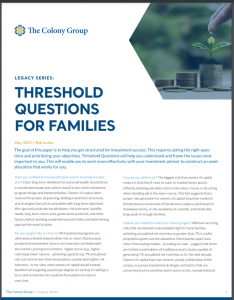Legacy Series: Threshold Questions For Familes
The goal of this paper is to help you get structured for investment success. This requires asking the right questions and prioritizing your objectives. Threshold Questions will help you understand and frame the issues most important to you. This will enable you to work more effectively with your investment advisor to construct an asset allocation that works for you.
Have you codified formal wealth goals and an associated estate plan? Clear, long-term ambitions for personal wealth should drive a coordinated estate plan, which should in turn drive investment program design and implementation. Owners of capital often reverse this proper sequencing, abiding investment structures and strategies that are incompatible with long-term objectives. We rigorously evaluate tax attributes, risk tolerance, liquidity needs, long-term return aims, governance protocols, and other factors before building comprehensive portfolios and determining appropriate asset location.
Do you target risks or returns? All investment programs are ultimately oriented toward either risk or return. But because prospective investment returns are inversely correlated with the market’s pricing environment – higher prices (e.g., higher risk) imply lower returns – achieving a goal of, say, 7% annualized net real returns over time necessitates considerably higher risk tolerance. In our view, most owners of capital would instead benefit from targeting a particular degree of risk that it’s willing to incur and to tolerate the resultant fluctuations of returns
over time.
How do you define risk? The biggest risk that owners of capital endure is that they’ll react to mark-to-market losses poorly, either by standing pat when action is the wiser course, or by acting when standing pat is the wiser course. This fact suggests that a proper risk parameter for owners of capital should be rooted in the behavioral constraints of the decision-makers and framed in drawdown terms, or the avoidance of a specific and intolerably large peak-to-trough declines.
How do you intend to meet your return targets? Without incurring risks that are deemed unacceptably high for many families, achieving annualized net real returns greater than 7% is a lofty proposition given current valuations. Most passive asset class return forecasting models – including our own – suggest that there are limited combinations of traditional asset classes capable of generating 7% annualized net real returns for the next decade. Owners of capital have two choices: accept a diminution of the corpus, or pursue investment strategies and tactics that are uncommonly price sensitive and in some circles, considered bold.
How diversified is your portfolio, defined as the sum of all directly and indirectly held positions? In an all-equity portfolio, research suggests that as few as twenty stocks is sufficient to deliver meaningful diversification. Yet many portfolios – institutional as well as personal – are laden with thousands of indirect holdings, suggesting almost no confidence in any of the managers employed to choose them. The result is a passive-looking portfolio with active-looking fees. The value of active management is only apparent with concentration.
How costly is your portfolio, taking into account the asymmetry of carried interest? Most modern portfolios are too expensive as those shepherding them are unwilling to optimize fees and costs by utilizing directly held positions when warranted, and by culling manager rosters to a reasonable number. In particular, too many managers capturing performance-based rewards creates a subtle and additional fee drag, as “down” managers generating losses aren’t netted against “up” managers generating gains. To be sure, other family portfolios we’ve encountered are too cheap, relying to an unappealing extent on indexed exposures that forego certain achievable sources of active management “alpha” (e.g., security selection skill).
What role does active management play in your portfolio? Active management is a highly useful tool when applied to markets with inefficient pricing, usually due to a wide dispersion of skill or time horizon among participants. Unfortunately, some so-called “active managers” concern themselves with relative returns and tracking error for business as distinct from investment reasons. Risk adjusted returns can improve materially by favoring those active managers who could be viewed as having a verifiable and persistent edge, who have clear and logical mandates, who operate a concentrated portfolio of well researched and long-term holdings, and who offer fees and terms that align GP and LP interests (e.g., rewarding for skill rather than for luck).
What role do passive instruments play in your portfolio? In markets or for exposures where active managers are poorly suited, the proliferation of low-cost passive investment instruments is a boon to investors. There is one caveat capitalization- weighted indexes are intrinsically momentum oriented, with appreciating constituents capturing larger weights at the expense of depreciating constituents. This byproduct of index pricing reduces turnover and hence realized gains, but also reduces pre-tax returns over time. Tax advantaged quantitative strategies designed to minimize the slippage between pre- and post-tax returns while providing index-like exposure is one way to pursue tax- and fee-sensitive allocations without compromising after-tax results.
What role does illiquidity play in your portfolio? Traditional private equity (PE) is an increasingly crowded arena with certain Lake Wobegon similarities – all the children are above average and all the funds are top quartile. A theoretical illiquidity premium still exists in capital markets, but PE investors’ ever-compressing investment horizon – a consequence of incentives to effect exits that lock in carried interest and goose IRRs at the expense of MOICs – and the quantity of capital sloshing among private markets make traditional serial fund PE a poor, tax-inefficient proxy for genuine illiquidity. In fact, many PE firms we know have higher portfolio turnover than certain of our public equity managers. Accessing via distinctive structures stakes in assets that are inaccessible to traditional PE investors – closely held family businesses, for example – may be the next frontier for those whose time horizon affords them the luxury of living with true illiquidity.
What role does cash play in your portfolio? One of the only things investors can control is the price paid for an asset. Yet, modern asset allocation frameworks systematically undervalue the option value inherent in ready liquidity. The recent rise in rates gives cash reasonable returns and provides the wherewithal to access future opportunities at more attractive prices – opportunities that historical data confirm almost always appear. Such discipline is improperly slurred as “market timing,” as it’s merely the logical outgrowth of price sensitivity. Nimble capital owners and advisors with the incentives and behavioral attributes to wait until the risks of deploying capital are justly compensated have a what we view as a distinct advantage over those perpetually ensuring that capital is “working.”
How confident are you in the asset allocation models underpinning your exposures? Asset allocation models rooted in backward- looking return and covariance data are increasingly outmoded, as they assume asset pricing conventions and relationships are static through time, and they encourage the examination of exposures through a solitary and decreasingly useful prism (e.g., asset classes comprised of emerging markets, alternatives, hedge funds, etc.). Moreover, conventional strategic allocation guidelines (e.g., minima, norms, and maxima) for asset classes also tend to drive investment decision-making, replacing judgment with
price insensitivity.
How do you intend to assess the slippage between pre-tax and after-tax results? Most investment programs are poorly suited to providing useful context for the tax consequences of allocation decisions. As a result, many capital owners are insufficiently sensitive to tax outcomes, a flaw that could prove devastating over time as political winds and societal demands point toward higher marginal tax rates. We believe the integrated pursuit of low turnover strategies, of concentration, of tax loss harvesting and gain management, and of asset location expertise is the best means to optimize after-tax returns. There are many structuring tactics and portfolio management disciplines that a proficient and properly incentivized advisor can employ to optimize tax burdens.
ROB INCHES
Senior Portfolio Manager, Institutional Advisory Practice
As a Senior Portfolio Manager in the Institutional Advisory Practice team at The Colony Group, Rob provides comprehensive solutions to the investment, wealth planning and philanthropic needs of owners and stewards of substantial capital. Rob is a financial professional with more than 34 years of experience in the wealth management industry.
Rob has written on alternatives to fixed income, redefining growth and value investing, the impact of innovation on investment decisions and ensuring a successful family legacy. Rob’s experience gives him a perspective on all aspects of family legacy planning with an emphasis on investing.


